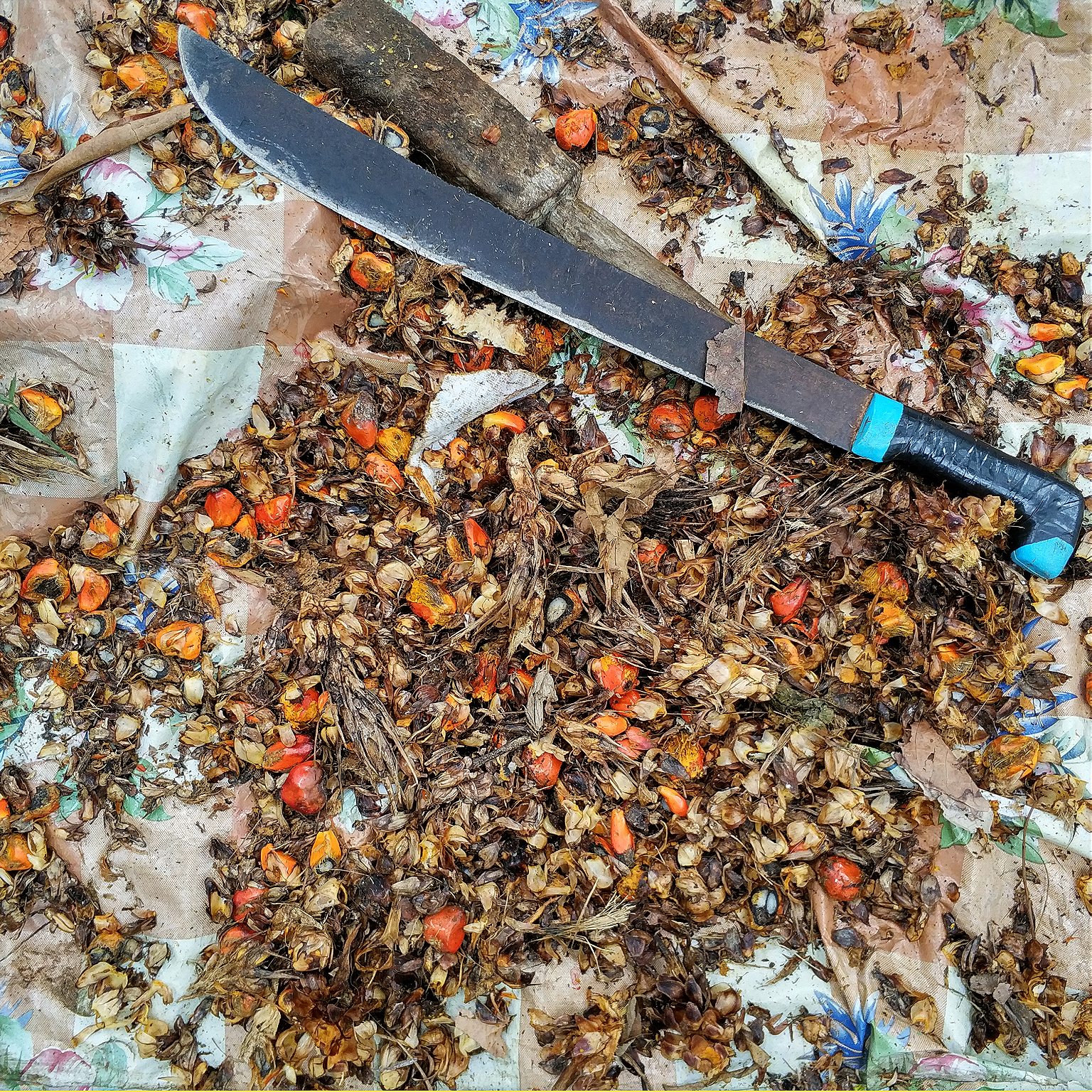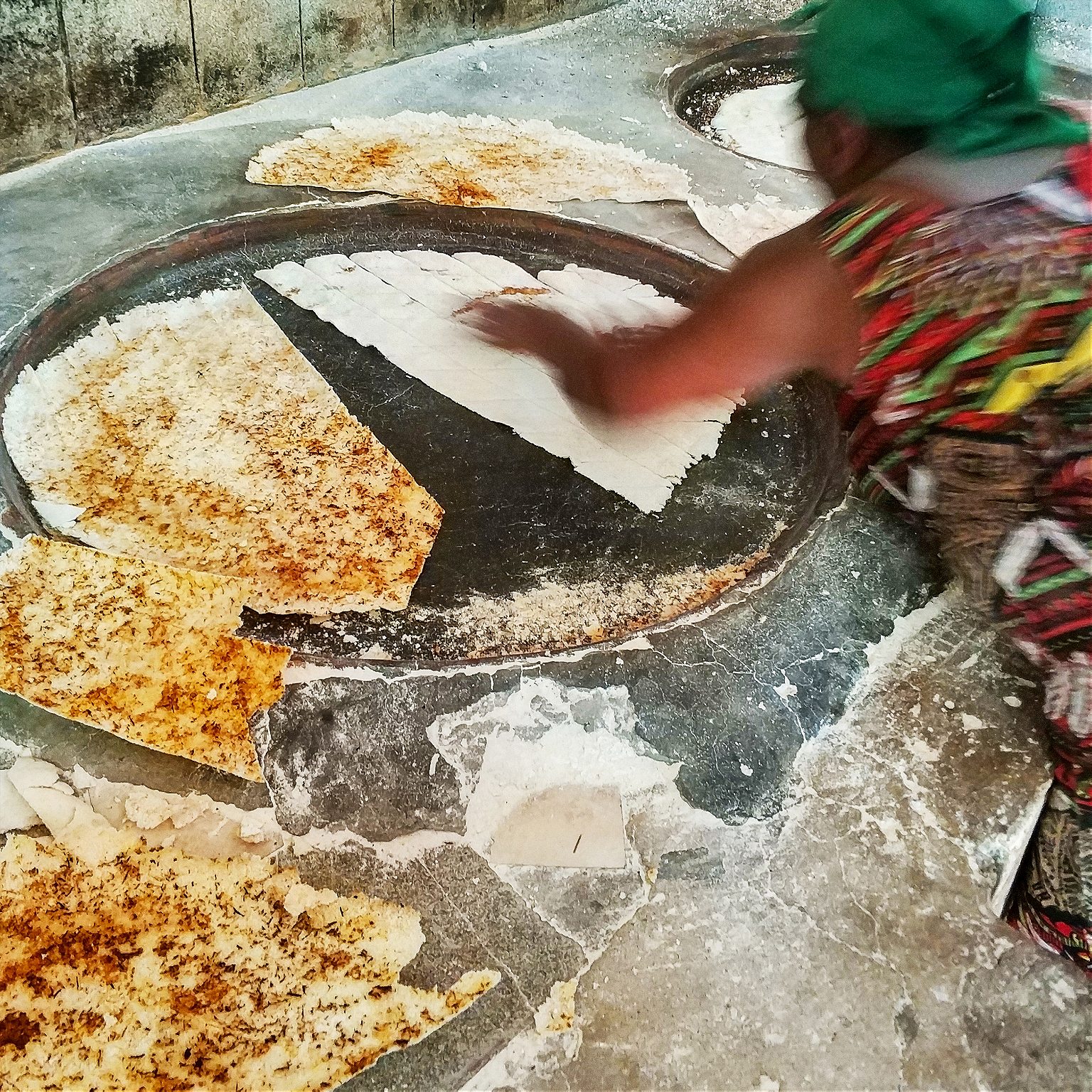In Salvador de Bahía, Spanish food writer Pau Arenós experiences a campfire banquet that showcases the faith, traditions, and ingredients of the Tereré quilombo—a community built by former slaves.
Lead in the sky and the water. Grey clouds and waves of ash. Beneath and above the dull hues, bounces the ferry that crosses from Salvador de Bahía and the island of Itaparica, leaving in its wake the big city—the anthill surrounding the Lacerda elevator, which since 1873 has taken on a double mission: one as a tourist attraction and the other as a connector between the port and the Cidade Alta.
The ferry is a local shuttle, carrying tourists who want to explore the place the Portuguese named “Bay of All Saints” in honor of the church and the calendar—the explorers arrived on November 1, 1501: All Saints Day. The city was mapped and “discovered” by Amerigo Vespucci, according to the European version of history (never mind that the Tupinambá people had been there long before). Only 10 kilometers (just over six miles) and 45 minutes separate the concrete of Salvador from Itaparica.
From the shore of Itaparica, the skyscrapers of Salvador look like flowering gray mushrooms. The rundown taxi from the port of Vera Cruz to the Tereré quilombo—a community built by former slaves—bounces along a cobblestone road, passing by skinny dogs (a sign that hens must be nearby).
Beneath the palm trees are the homes of Tereré’s 2,100 inhabitants, as well as other structures that are home to the gods—or at least their representatives. We’re in Candomblé territory, the Afro-Brazilian religion that worships the orixás—divine entities—and which has 3 million followers in the country. Salvador de Bahía is a center of Candomblé faith.
After walking past a structure that could be confused for a toolshed, Reitel, a capoeira instructor and leader of the quilombo, his dreadlocks contained in a turban, says: “That’s where Exu lives. You have to ask permission for what we’re going to do today.” To visit with strangers, to eat, for the banho de folhas—herb baths. In a tree in front of the little house, Exu is represented by a metal figure straddling a branch. To the uninitiated, it simply looks like a rusty iron sculpture.
In addition to the spirits’ dwellings, the most important buildings in the quilombo are the Casa da Memória and the Casa da Farinha, the houses of memory and wheat, respectively. Both are dedicated to things that change over time—that may seem light but in fact are anything but. The word casa also means refuge. The Casa da Memória remembers a past that was cruel, bloody, genocidal: we must not forget. We must not forget the millions of slaves torn from Africa—of 60 million, 12 were enslaved in Brazil. Theirs were the bones on which countries like Portugal, Spain, Great Britain, France, and the Netherlands built their empires, their skins the sails of the ships that brought them here. The residents would be right to receive white visitors with anger and sticks, but instead, they welcome us with smiles.
Visitors might not recognize the meaning of pelourinho, the name of the colorful and beguiling neighborhood in Salvador, where women in traditional dress charge passersby to take photos by their sides. It means “pillory” and refers to the log of wood, installed between 1807 and 1835, to which rebellious slaves were tied and lashed, sometimes 300 or 400 times over the course of days—although some died on the spot. Paths of blood formed across their backs. The beatings were carried out almost every day. The cries of those raw ghosts echoed across the neighborhood’s pastel-colored walls.
Chefs Fabrício Lemos and Caco Marinho both have restaurants in Salvador. Fabrício is the owner of Origem, and Marinho of DOC. Both aim to raise awareness of ingredients from the Tereré quilombo: manioc flour and palm oil. Both get by with a barebones pantry, but the goal is to increase production so that the community can live off it—for the moment they are self-sufficient.
Fabrício explains how he became involved with the collective: “We arrived in 2017. We were researching Casas de Harina and we found this one. We committed to improving production so more families generate income. We got the support of the state government, and renovations will begin in 2020.” This is faith: not in the saints or the orixás, but rather in the devil that is government.
Reitel signals toward the palm trees from which they’ll extract the palm oil—dendé. Their process is nothing like that employed by large, multinational companies, whose practices have damaged forests across the planet.


On a plastic table sit machetes and palm fruits, red as embers, which they’ll add to a metal pot. Reitel takes a mallet crushes the fruits, releasing their oil. With gloved hands, they separate the husks from the liquid, reheating them, this time with leaves. The yellow turns to orange.
The next stop is Casa da Farinha. Along the way, we see pieces of clothing, strewn among the palm trees, the wooded hills, and the pebbly hills; a donkey and its foal stand in the middle of the road before a field of yucca and unfinished houses.
Fabrício has bought a family’s entire yield for the day. An older couple and a young woman with a baby heat the flour on clay plates atop a wood-burning stove. At the instruction of the older woman, the girl, wearing a patterned dress and green headscarf, her bare feet covered in dust, moves the burning logs with a stick, reducing the heat.
Extracting the manioc flour is a slow and painstaking process. Without treatment, tucupí, the liquid that is extracted from wild manioc root, is toxic. The flour must be ground, kneaded, left to sit, toasted, and ground again. Handlers use wooden instruments so as not to burn the flour.
Later, the flour will be used to make beijú, a cake that transforms from spongy to crunchy. The woman with the green headscarf flips the cake and sprinkles it with coconut flakes, then cuts it into pieces. Despite the humidity, she had just made a delicacy to be eaten bite-sized, like croutons stolen from the bag on the way home from the grocery store.
All is done with the permission of Exu. A few hours earlier, Fabrício and Caco bought meats for a barbecue at the Vera Cruz market. Doña Juanice, a priestess dressed in white, will oversee the feast, which will take place in front of some of the larger homes. A long wood table, covered with bottles of cachaça that will spill over amid toasts and revelry, will receive offerings.
Many everyday meals in Bahía are in some way related to the religion
The grill is placed over some bricks, and the lobsters are split down the middle. Caco, his beard taking in the cigar smoke, watches over the grill. Soon, they’ll be drinking to the gills. On the other grills are pots of shrimp and moqueca de peixe—fish stew, thickened with manioc flour—and crabs, which Fabrício will bless with the fresh dendé.
Fabrício is well-versed in Candomblé: “Many everyday meals in Bahía are in some way related to the religion.” When he was 17, he emigrated to Miami, where he worked as a waiter and dishwasher. It was there that he met Augusto Soledade, whom he describes as an “Afro-Brazilian dance choreographer.” Fabrício considers Augusto to be his “spiritual father” and says he helped him find his calling as a cook.
Two nights after our campfire dinner, Origem, the restaurant that Fabrício has helmed with the pastry chef (and his wife) Lisiane Arouca since 2016, would be awarded “best restaurant” and “best chef” by the respected Vela magazine. The accolades were well deserved: the tuna Béarnaise, served with beets and crispy rice, octopus with chili, coconut, and tapioca are formidable dishes: “Simple, and with heart,” as Fabrício says.
And yet, for some reason, these dishes do not have the emotional impact of those crabs seasoned with dendé. Something singular happened the night on Itaparica: time and space flowed in harmony, fingers stained, mouths—full—laughed and downed the cocktails made by Júnior, Origem’s bartender, whom Fabrício brought along and who improvised mixed drinks for the party. Ah, the torture of drinking one gin after another with ginger, pineapple, and lots of ice!


If an imaginary camera had been filming the banquet, it would have captured an anxious group pouncing on the massive pans of food, mixing—with the imperfect beauty of the handmade—the lobsters, crabs, prawns, cooked fish, rice, the spicy sauce with crispy vegetables in clay bowls, tilting the containers to collect the broths, removing husks and serving life—that flash of life!—as the grills exhale the last of their fumes. It was authentic and irreplicable.
But the chef repeats: “The goal is to bring tourists and students to the quilombo. To generate income for the families from sales of the flour and palm oil.”
The natural surroundings differentiate this dinner from the pomp—waiters, servers, silence, cloth napkins, tablecloths—of a restaurant, where, no matter how relaxed the service, is still a reproduction of the master-servant relationship. The lack of inhibition and spontaneity of this meal make it unlike anything one might experience in a conventional dining room.
There remains the fourth act, the herb bath, which, in Fabrício’s words, “Protects against envious people, brings good luck, and cleanses the soul.” Some need it intensely and urgently. Mrs Juanice tells me to wash thoroughly. In a tin-roofed shed, the ialorixá, the priestess, takes the water from a well. In Candomblé—as in any community—the source of water is a prominent element. It guarantees survival.
The priestess has mixed the water with sacred herbs for the Amaci ceremony: Pour three buckets of greenish water on the naked body. It’s cold as a machete’s blade, but three pours can ward off the evil eye. In the distance, people have started doing capoeira. We can hear the vibrant monotony of the berimbau.
After drying off and warming up, Caco offers me a Bahian cigar. He knows his smoke—as he demonstrated with the lobsters. Between the aromatic vapors of the cigars, the mosquito repellent, and the elastic moves of the capoeira dancers, an elderly woman beats a metal plate, as if the rhythm itself were keeping her alive. And all that which looks like poverty and superstition have become natural and close, adopting the beauty and persuasiveness of the unexpected.






